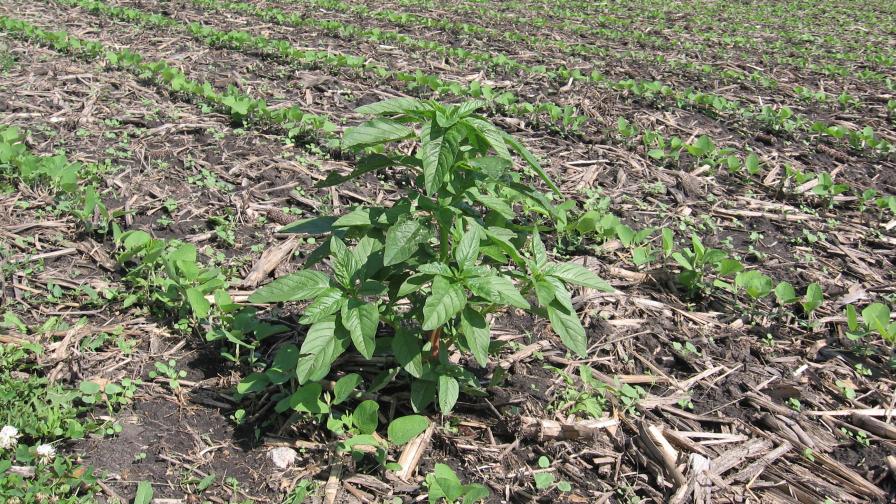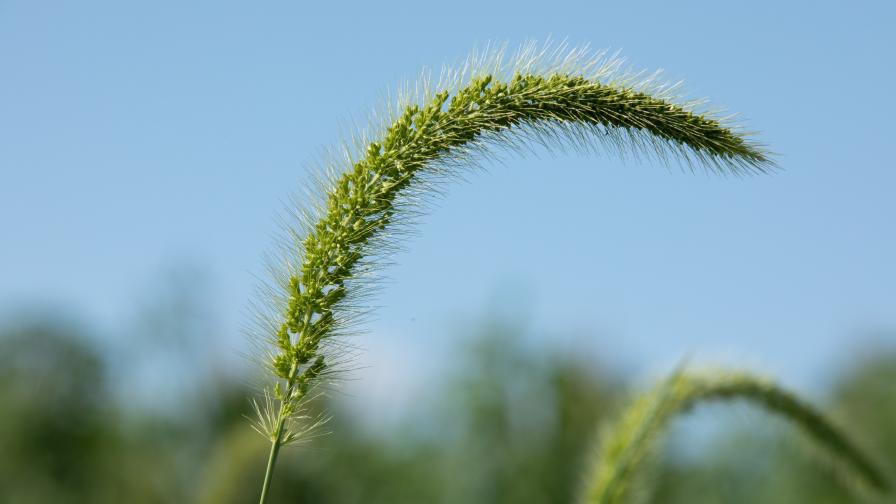Herbicide-Resistant Weeds: A Tough Problem That ‘Ranks Right at the Top’ for Ag Retailers, Growers

The evolution of herbicide-resistant weeds is one of the most significant developments in agriculture today. Photo: Palmer pigweed, 16-18 inches, in soybean stubble.
Editor’s note: This article originally published in April 2021.
In the classic 1993 movie “Jurassic Park,” chaos theorist Ian Malcolm described to everyone how the genetically-engineered dinosaurs have managed to get around all the breeding precautions put in place by the scientists using this phrase: “Life finds a way.” Unfortunately, in the world of agriculture, one could replace the word “life” with “weeds” and this statement would be just as accurate today.
Since the beginning of the biotech crop age in the late 1980s, herbicide-resistant weeds have steadily grown in both species types and overall numbers. To appreciate just how rapidly these genetic mutations are progressing, consider the case of the latest herbicide-resistant weed species to be discovered in just the past few months.
Back during the late 2019 and the summer of 2020, weed scientists from the University of Arkansas found two populations of Palmer amaranth in Crittenden and Mississippi counties that seemed to be resistant to the popular herbicide glufosinate. According to the research, one population of these weeds were found to be resistant to 3.5 times the normal application rate; the other was resistant up to 15 times the normal rate. Following testing, the glufosinate-resistant Palmer amaranth was confirmed, with the university announcing these findings in late February 2021. This made these varieties of Palmer amaranth only the second confirmed glufosinate-resistant weeds in the world (behind a variety of Italian ryegrass discovered in Oregon and California back in 2010 and 2015, respectively). However, this is the first confirmed broadleaf weed to develop glufosinate resistance.
At the moment, wrote University of Arkansas Extension Weed Scientist Tom Barber in an online post, the glufosinate-resistant Palmer amaranth does not seem to be widespread. “Currently, this problem does not appear to be widespread across Mississippi and Crittenden county or the northeast Arkansas area based on extensive screenings that have been taking place in this geography,” said Barber. “Although it stands to reason that several other fields likely contain small segments of the Palmer amaranth population that has reduced sensitivity to glufosinate.” He added that the university weed scientists were currently testing glufosinate-resistant Palmer amaranth for resistance to other modes of action as well, with final results pending.
How did this latest herbicide-resistant weed develop in the first place? According to some experts, it’s possible these species could have evolved during the Prevent Plant Event of 2019, where cool and wet weather across much of the U.S. kept many farm fields from being planted/treated as they normally would have been. Based upon statistics from the USDA, approximately 19 million acres of cropland wasn’t planted/treated during 2019. And in Arkansas, this acreage totaled more than 1.3 million acres.
Of course, adds Dr. John Pawlak, Senior Product Development Manager for Valent USA Corp., these varieties of Palmer amaranth could have just been building up tolerance to glufosinate for several years prior to 2019 — just as other species of this type of weed have been doing for the past 20 years or so. “No matter how this weed came about, it still means the same thing — another herbicide potentially losing some of its effectiveness in controlling invasive weeds,” says Pawlak.
The Numbers Game
Overall, the numbers are somewhat mind-blowing. Just a few years ago when CropLife® put together its annual look at herbicide-resistant weeds, most market watchers estimated the number of resistant varieties barely topped the 200 mark. By the end 2020, however, weed scientists estimate that there are now more than 500 herbicide-resistant weeds spread out across the globe. In all, these varieties have evolved resistance to 23 of the 26 know herbicide sites of action and 167 different herbicides overall.
“The evolution of herbicide-resistant weeds is one of the most significant developments in agriculture today,” says Dr. Aaron Hager, Extension Specialist, Weed Science, at the University of Illinois. “In terms of tough issues facing today’s farmers, this has to rank right at the top.”
Indeed, this view is supported by the majority of ag retailers. In a weed survey conducted by CropLife back during the fall of 2020, 40% of respondents said that in their opinion, the state of weed control in agriculture was “volatile, as bad as I’ve ever seen it.” Another 37% said weed control remained volatile, “but was not as bad as it once was.” Only 16% of survey respondents said weed control was “getting better” than in prior years. The remaining 7% weren’t certain what the current state of weed control in agriculture was like.
Of course, most experts will say that many of these weed control problems tie back to the agricultural industry’s overreliance on certain popular herbicides such as glyphosate — which has given weeds time to adapt over the years. Therefore, in recent years, crop protection suppliers have introduced new cropping systems based upon different/older chemistries to fight back, with both dicamba– and 2,4-D-resistant crops debuting into the market. According to industry watchers, these have helped control the spread of many glyphosate-resistant weeds since 2017, when they were introduced.
These introductions haven’t gone entirely smoothly, however. For the first year or two after dicamba-resistant crops began moving into crop fields across the country, some off-target drift damage issues have dogged agriculture. This, in turn, led to numerous lawsuits and court battles.
In June 2020, these seem to come to a head when the Ninth Circuit Court of Appeals ruled that dicamba’s re-registration in October 2018 was invalid. This ruling made applying dicamba formulations from three suppliers — Bayer Cropscience, BASF, and Corteva Agriscience — illegal across the U.S. One other formulation, Tavium from Syngenta, was not affected by this ruling, however.
Government regulators eventually stepped in and allowed existing stocks of dicamba to be applied throughout the summer 2020 months. And in October 2020, EPA re-registered new labels for dicamba formulations from Bayer and BASF for a five-year time period.
“Growers have been clear how vitally important this tool is for their weed-management programs,” said Alex Zenteno, Bayer Dicamba Product Manager. “The EPA’s strong science-based decision and new measures, including the introduction of VaporGrip Xtra Agent, will help growers use the product even more successfully. We look forward to working with growers to ensure they are aware of the new XtendiMax herbicide label and prepared for the upcoming season. We take our stewardship responsibility very seriously, and we will continue to enhance our trainings, resources, and other support.”
Scott Kay, Vice President of U.S. Crop, BASF Agricultural Solutions, said something similar regarding the re-registration of the company’s Engenia product. “The need for Engenia herbicide is greater than ever before due to increased weed resistance. When the weeds win, farmers see the impact to their livelihoods, harvests, and yields,” said Kay. “Controlling resistant weeds is not only a physical challenge for farmers, it also can have a significant financial impact. It is estimated that certain resistant weed populations can reduce yields by 50% or more. This means that farmers planting dicamba-tolerant cotton and soybeans could potentially stand to lose more than $10 billion if they lost access to dicamba-based herbicides, like Engenia herbicide.”
The news wasn’t all good on the dicamba front, however. The third company that had its original registration voided, Corteva, announced in February 2021 that it was discontinuing its dicamba formulation FeXapan. Instead, the company is shifting its focus to its Enlist cropping system, which uses 2,4-D as its herbicide of choice.
“We see a strong demand and broad adoption of Enlist technology for seed and Enlist herbicide crop protection solutions,” said Corteva in a press release. “This decision allows Corteva to focus on customer and application training, sales, and distribution resources on our leading Enlist weed control system.” According to Corteva company data, Enlist crops were planted on approximately 30 million acres of U.S. farmland during 2020, and the company expects this figure to increase by another 10% during the 2021 growing season.
In support of its Enlist E3 soybeans, Corteva also launched Kyber herbicide last season. The new crop protection product is a preemergence soybean herbicide with three modes of action, including a Group 15 active ingredient. Kyber herbicide comes in a liquid premix. In addition to a Group 15 mode of action, it also contains active ingredients from Groups 5 and 14. The solution provides strong control of some of the toughest weeds farmers face, including waterhemp, Palmer amaranth, and common ragweed. Each mode of action in Kyber herbicide controls resistant weeds individually, and combined together, they provide a comprehensive solution. The herbicide also has extensive residual activity, lasting four to six weeks, even going beyond six weeks in the right conditions.
“We’re so excited to announce this product, because there’s clean and then there’s Kyber clean. By beginning a weed control program with Kyber herbicide, growers will be able to start the season clean by controlling weeds from day one,” said Aaron Smith, U.S. Product Manager, Soybean Herbicides, Corteva Agriscience. “The long-lasting residual activity in the solution will protect soybeans during that important, early growth stage until it’s time for a postemergence application. Young soybeans won’t have to compete for sunlight and nutrients with weeds.”
Old/New Approaches
Numerous crop protection suppliers are launching new herbicides to combat the ever-expanding list of resistant weeds in crop fields. Yet, according to Dr. Michael Kenty, Product Specialist for Helena Agri-Enterprises, “new” doesn’t always mean “new active ingredients.”
Take the company’s newest herbicide for soybeans, Antares Complete. Instead of using newer ingredients, Antares Complete unites sulfentrazone, s-metolachlor, and metribuzin in a concentrated formulation. “For effective weed control today, we need as an industry to get back to the way we used to do things, by trying for early weed control,” says Kenty. “All three of the active ingredients in Antares Complete have been around for several decades, but they gradually fell out of favor over the years. It’s time we got back to using them again to achieve pre-emerge weed control.”
For weed control in corn, Helena is also launching a different herbicide option. Called Empyros, Empyros Triad, and Empyros Triad Flex, these pre- and early post-emergence herbicides provide excellent control of broadleaf weeds and grasses with novel combinations of the newest HPPD inhibitor to hit the U.S. corn market. Empyros corn herbicides are built on tolpyralate.
“Tolpyralate is very strong from a post-emergence perspective, so along with activity on pigweeds, ragweeds, and other common broadleaf weeds, we’re also able to get really good grass control that you don’t see with some of the other HPPD herbicides currently in the market,” says Dr. Michael Cox, Crop Protection Specialist for Research and Development at Helena. “When we couple that with a residual herbicide, we get a really complete product that gives a nice punch from one formulation.”
Another new herbicide introduced last year is Acuron GT from Syngenta. Registered for post-emergence use in glyphosate-tolerant corn, Acuron GT combines bicyclopyrone with three other active ingredients — mesotrione, s-metolachlor, and glyphosate.
“Acuron GT has performed exceptionally well in field trials, averaging greater than 90% post-emergence control on all weed categories — large-seeded broadleaves and small-seeded broadleaves,” says Ryan Lins, a Syngenta R&D scientist in Minnesota. “In particular, its higher-level control of large-seeded broadleaves such as giant ragweed, morningglory and cocklebur, and pigweed species like Palmer amaranth and waterhemp, really sets Acuron GT apart from all other post-emergence-plus-residual herbicides.”
Also approved recently for expanded use was Impact Herbicide (topramezone+acetochlor) from AMVAC. It has now received federal EPA approval to apply up to 2 fluid ounces per acre in either single or sequential applications in corn. According to Nathaniel Quinn, AMVAC Marketing Manager for Corn, Soybeans, and Sugar Beets, this expanded use adds control of Texas panicum, field sandbur, and shattercane in tank mixes with atrazine, and increases the maximum size for control of yellow foxtail, fall panicum, woolly cupgrass, and broadleaf signalgrass.
“Impact Herbicide has been a mainstay of weed control programs for some time,” says Quinn. “We’re pleased to be able to extend Impact’s effectiveness to even more weeds and application situations.”
Another new herbicide is Katagon from Helm Agro US. Described as a next-generation HPPD pre-mix herbicide for post-emergence use in field corn, Katagon offers two modes of action with a co-formulation of the active ingredients tolpyralate and nicosulfuron.
According to Dave Schumacher, President of HELM, Katagon has demonstrated high performance ratings in crop safety and post-emergence control of glyphosate, PPO, triazine, and ALS-resistant weeds such as Palmer amaranth, waterhemp, ragweed, lambsquarters, and foxtails.
“In field trials, we’ve seen Katagon perform equal to if not better than several market leading post products on broadleaves and stubborn grasses,” says Schumacher. “Katagon is an ideal solution to help break the cycle of resistance without limiting growers’ ability to rotate to soybeans the following season.”
Moving forward, besides employing new herbicides, experts say that there are other important steps ag retailers and their grower-customers can take to combat resistant weeds. As a first step, Dr. Bill Johnson, Professor of Weed Science at Purdue University, recommends scouting fields and reviewing notes from the close of the 2020 season.
“I always try to encourage people to look at the subtle changes that are happening in the fields where you farm for a long time” says Johnson. “Is foxtail control getting more difficult? Is waterhemp making inroads in your area? Maybe it’s not in your field, but maybe you’ve got some neighbors who have it. Pay attention to the subtle things.”








